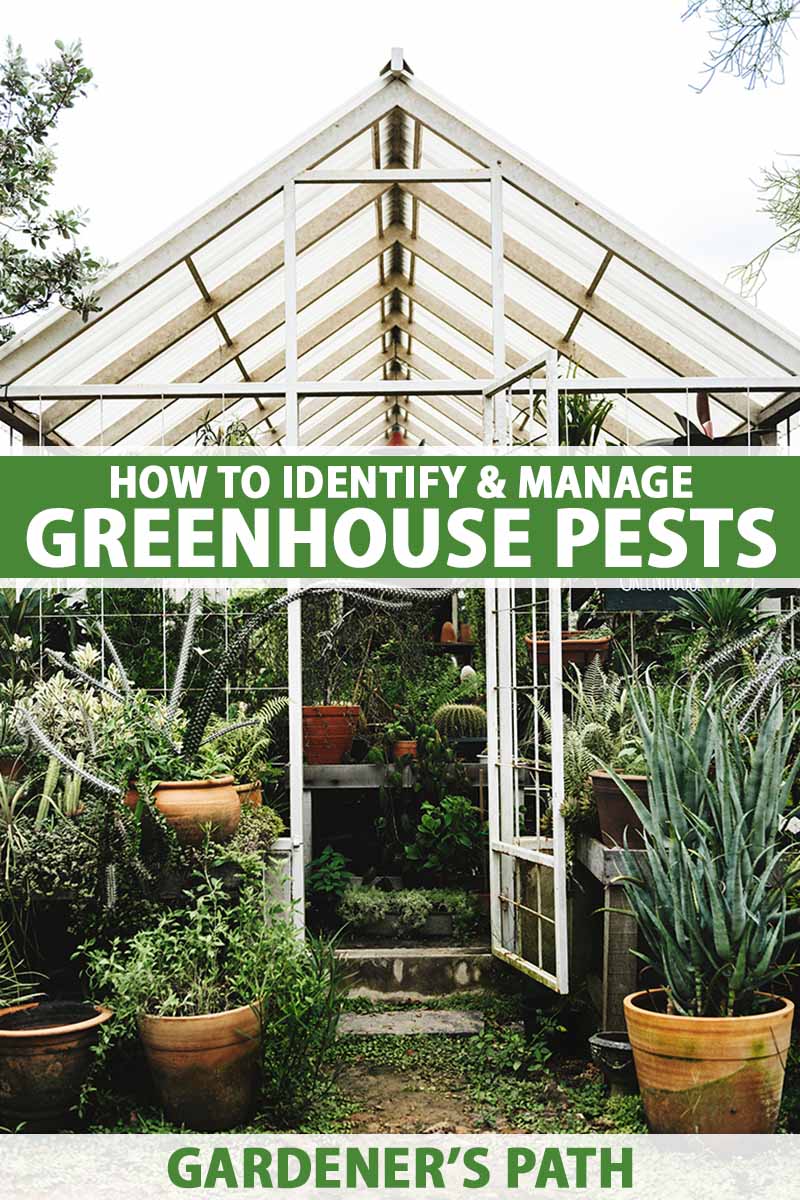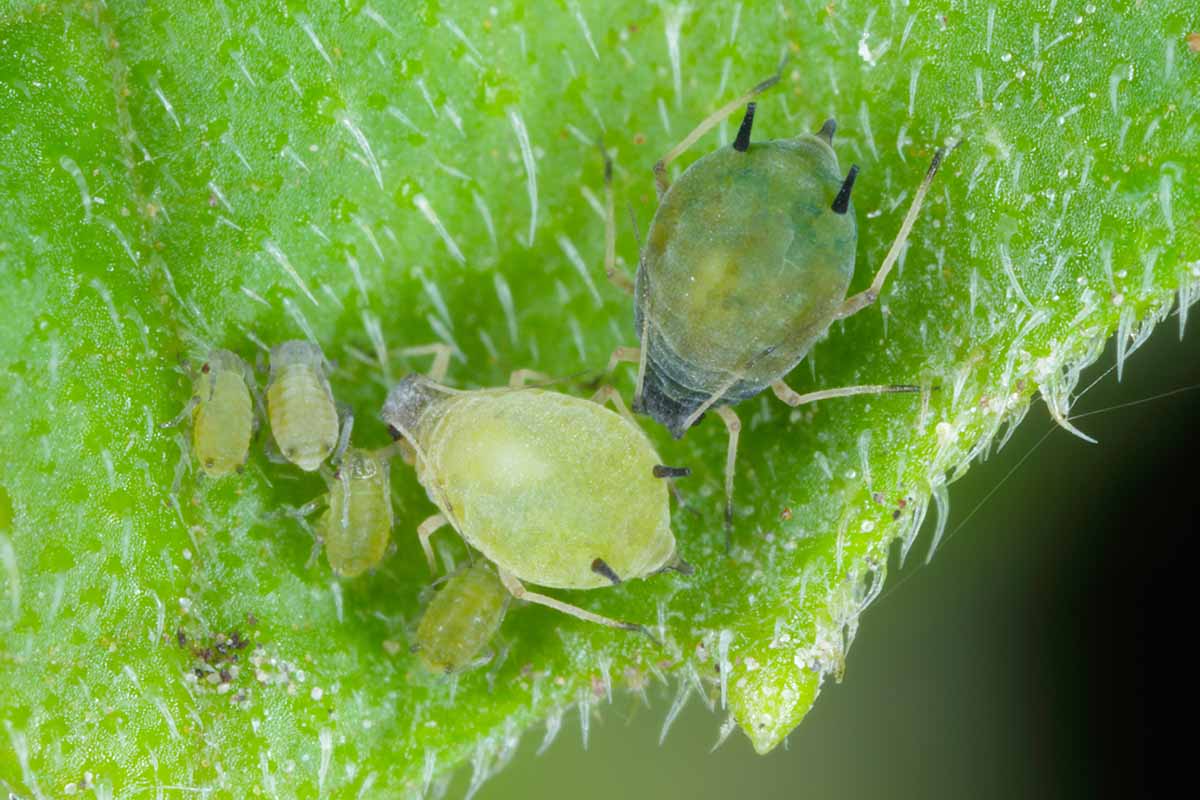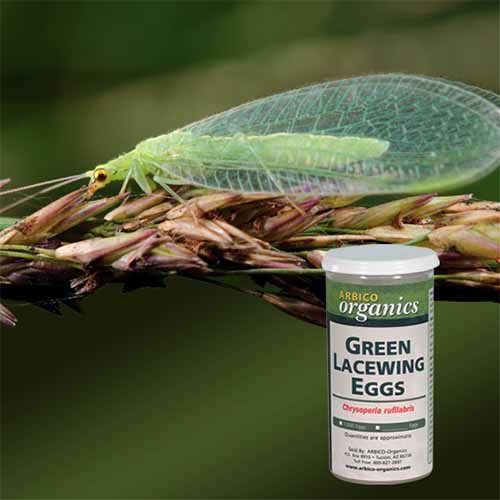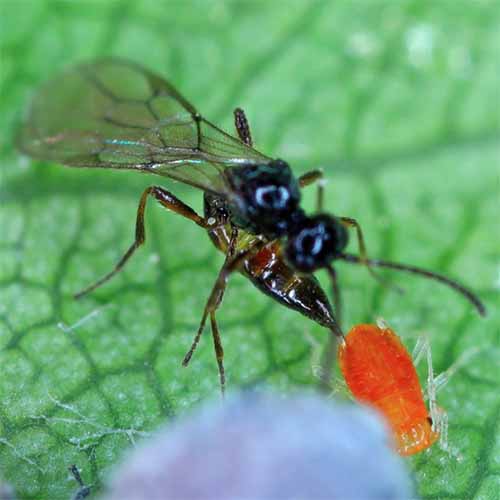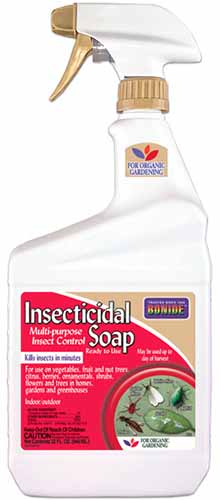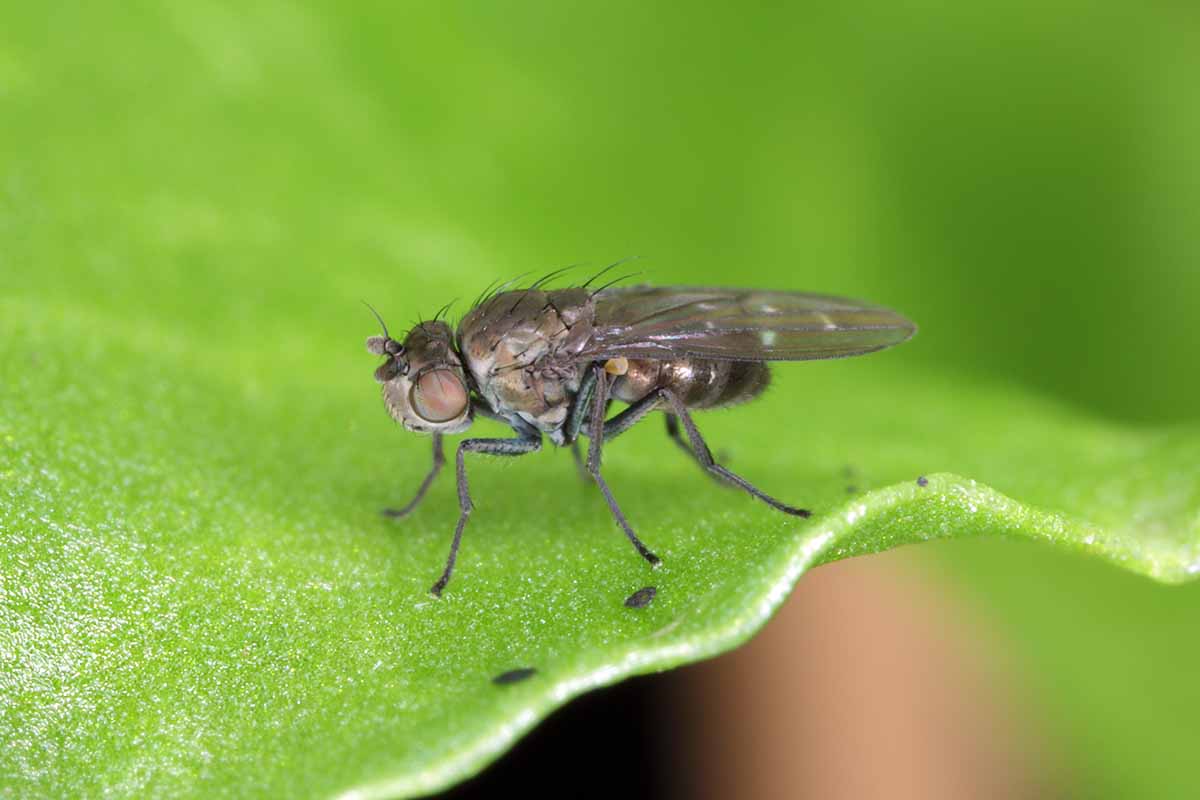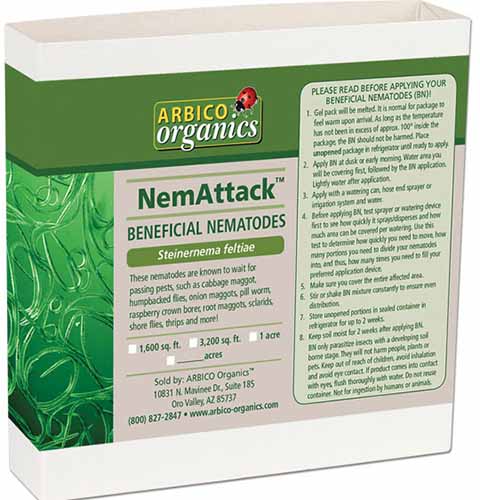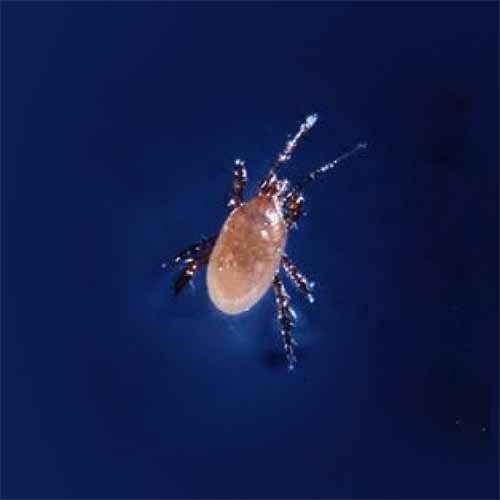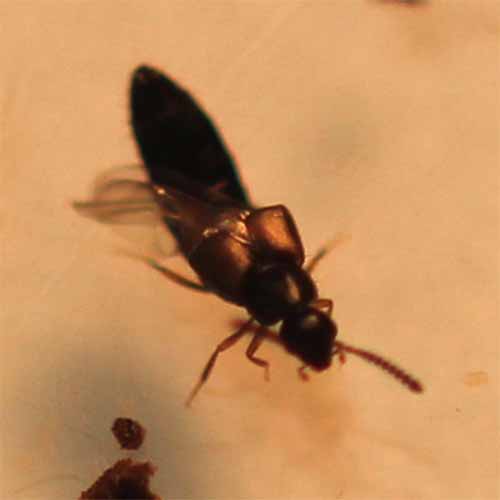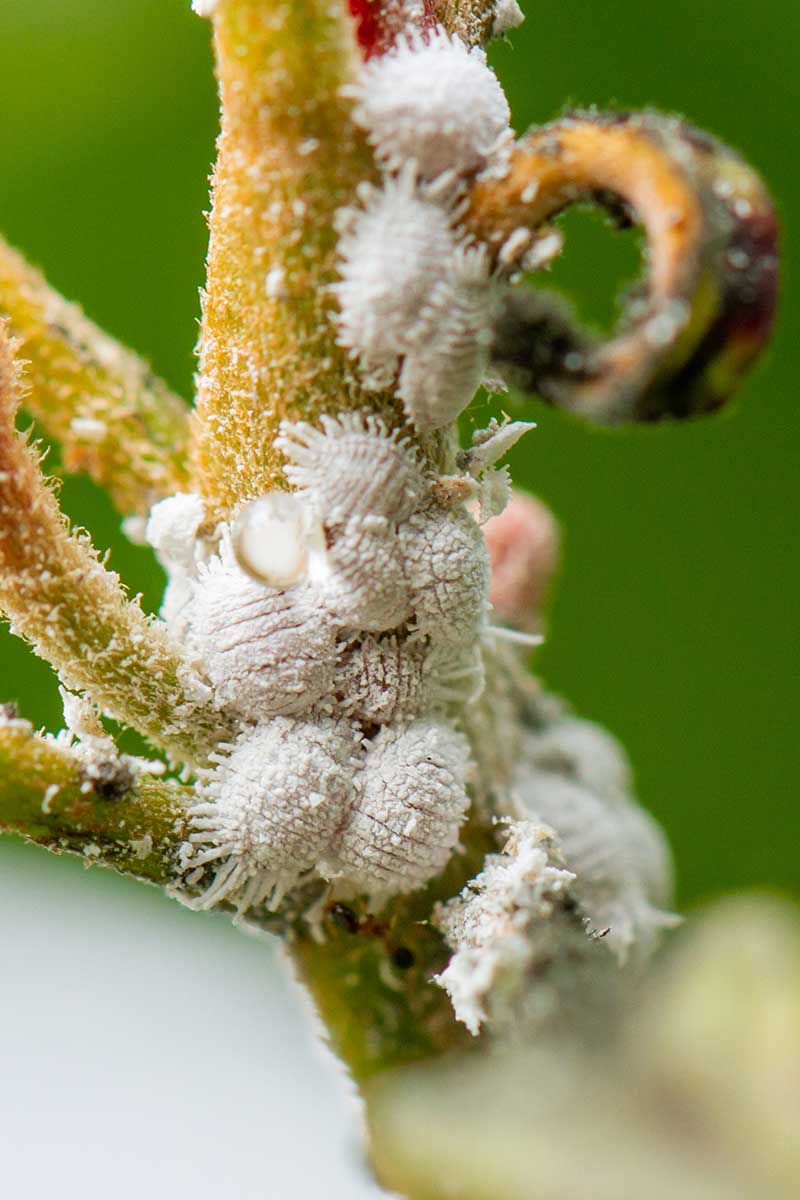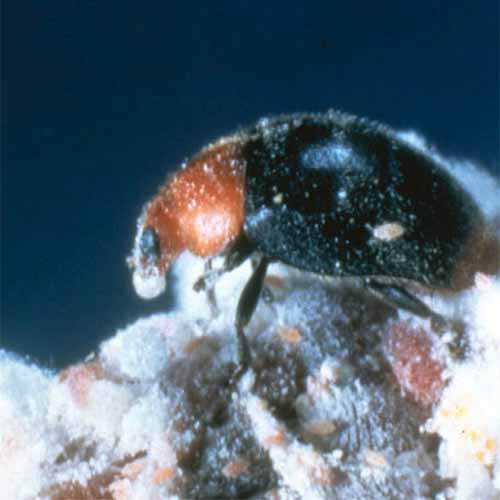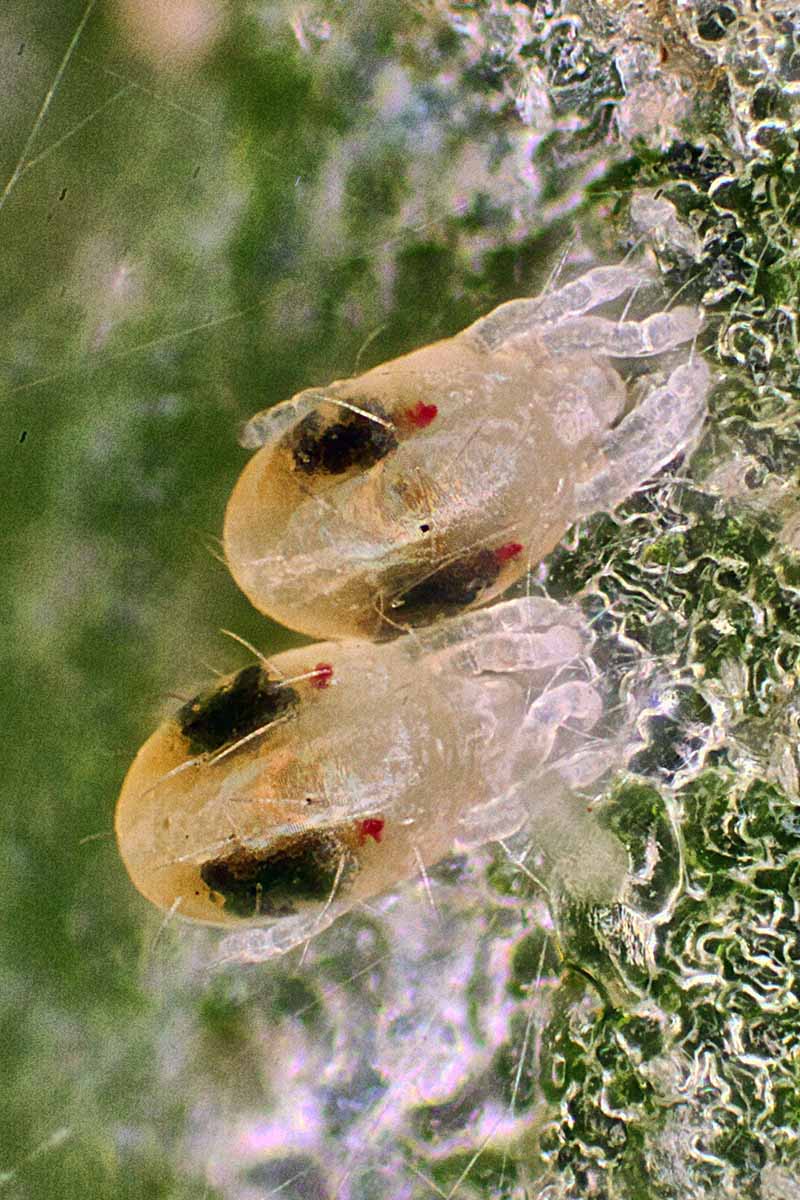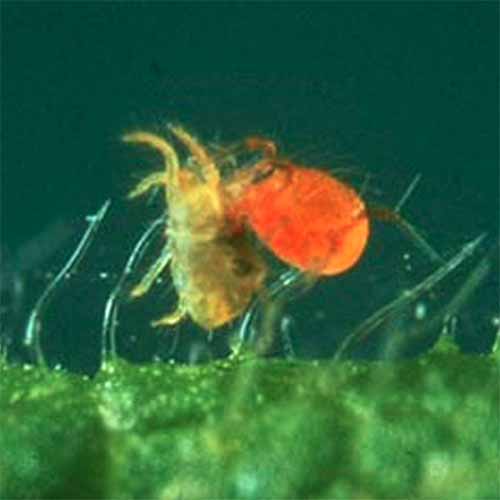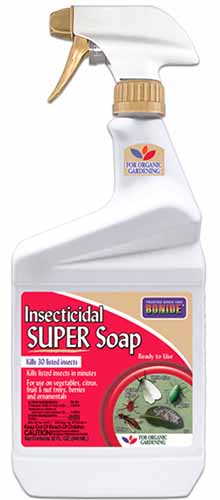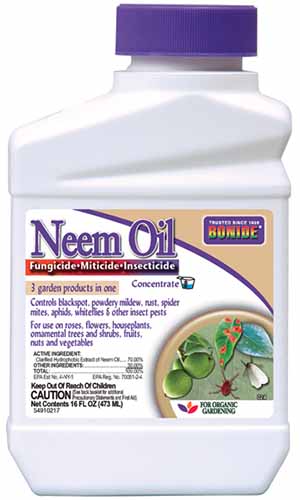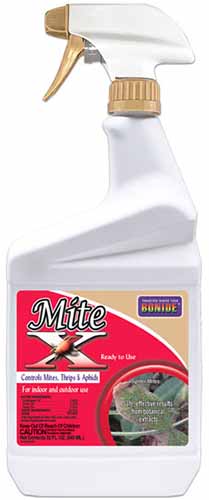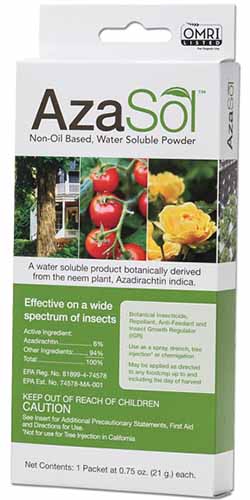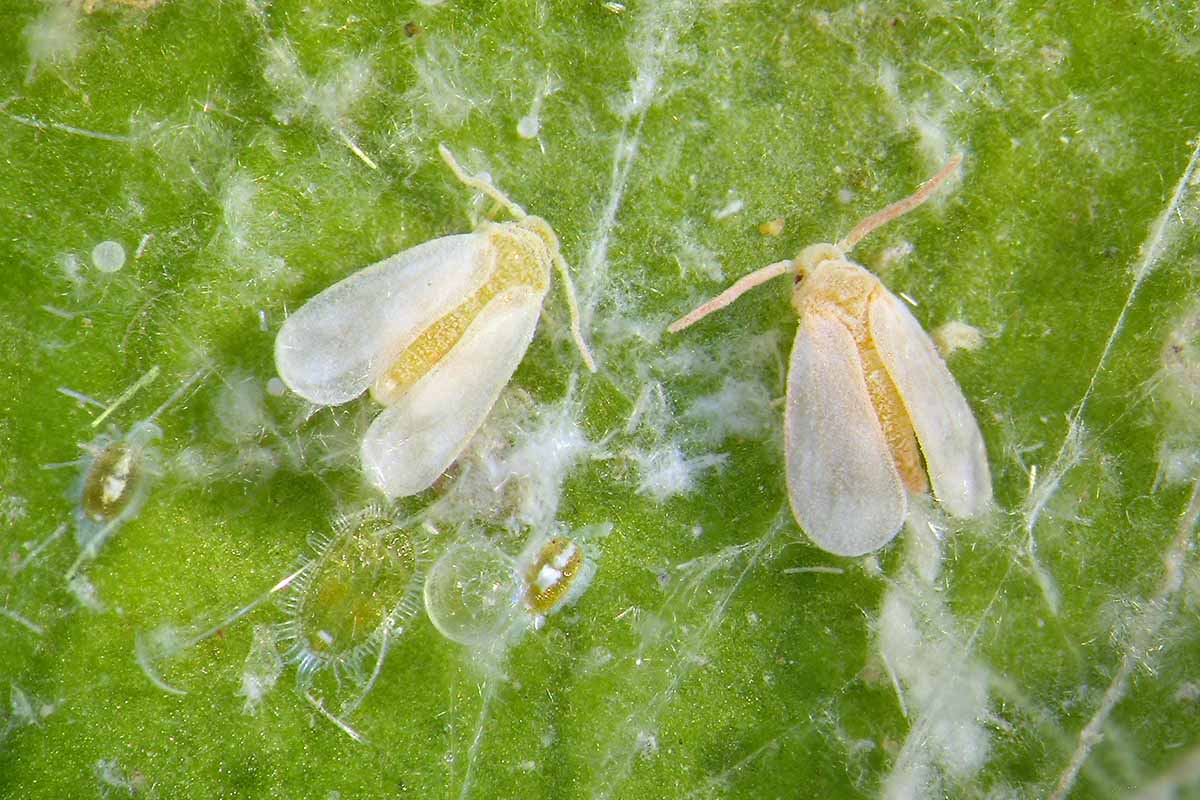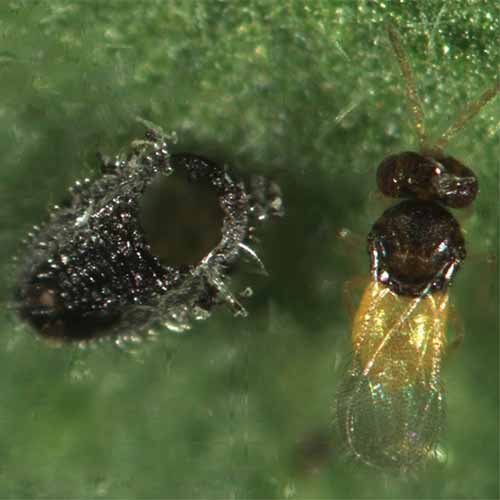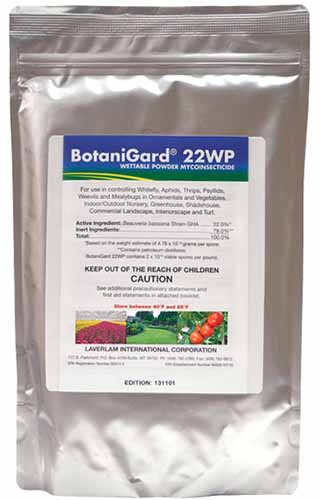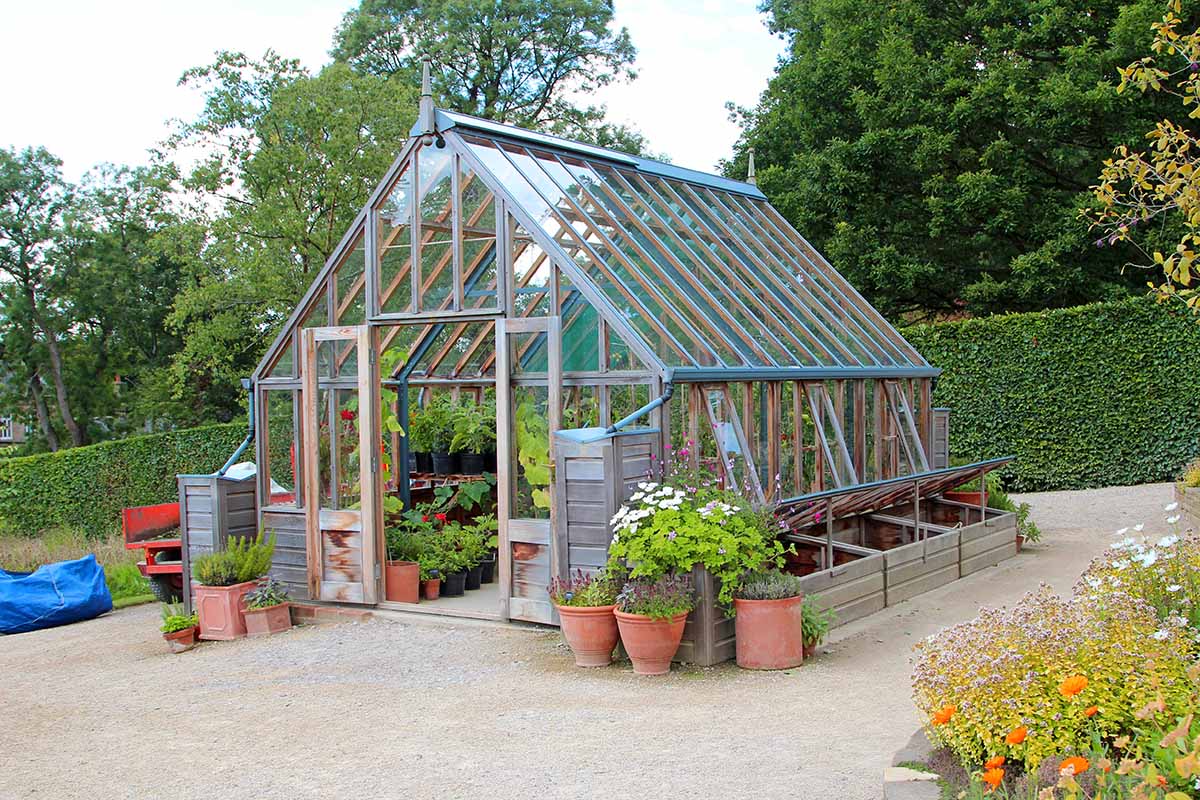We link to vendors to help you find relevant products. If you buy from one of our links, we may earn a commission. I wouldn’t always find each one of these pests, but I could count on finding at least a few, depending on the crop I was scouting. Greenhouses are notorious for harboring and nurturing populations of insects that are always on the verge of explosion. These protected growing environments are warm and wet, and they contain a buffet of plants to suit a variety of palates, including those of tiny creatures with six or eight legs. Often, there are no naturally occurring beneficial insects present, because while greenhouses do a good job of excluding certain pests, they also tend to keep out the good bugs. In this guide we’ll talk about each of the six pests I was constantly prowling for when I was doing this work, and how to manage them. Every greenhouse grower should know how to identify and deal with these common foes! Here’s the lineup of plant-damaging culprits:
1. Aphids
Encompassing a variety of different species, many of which are not picky about their host, you’ll find aphids on nearly every plant’s pest list. They are soft-bodied, most come in shades of brown or green, and they suck on plants until they nearly pop. They don’t though, thanks to two small “tail-pipes” on their backs that exude droplets of sticky-sweet honeydew. These were my arch nemeses as a scout. Able to give birth to six to 10 live young at a time that can give birth themselves seven days after being born, and not requiring the presence of any males to do so, their 20- to 30-day lifespan is multiplied across generations of exponential growth. Plus, they often aren’t easy to spot until it’s too late, particularly enjoying hiding on succulent stems and the undersides of leaves. Flipping leaves to take a look is muscle memory for me, so well ingrained that years later I still flip leaves and scan for bugs while browsing at my local nursery. And that’s not a bad tip if you’re shopping for plants! Both types of pests love wet conditions and the inevitable buildup of gunk in the greenhouse that algae loves to grow on. Whether or not the population size and damage caused by these two flies warrants control is another story. Ladybugs, parasitic wasps, and lacewings all attack aphids and can be introduced into greenhouse environments to help keep numbers low and knock aphid populations down. Green Lacewing Eggs You can purchase green lacewings at Arbico Organics. These are generalist predators, so they will target other pest insects as well. Certain parasitoids, on the other hand, are more specific to aphids. Arbico Organics carries a range of species with specific individual climate requirements. Some are better for pest prevention, and others are effective when introduced during the height of an infestation. Aphid Parasite Aphidius colemani, for example, is a braconid wasp that enjoys warm temperatures. This species is available from Arbico in a variety of package sizes. Bonide Insecticidal Soap Insecticidal soaps can also help if beneficial insects don’t do the trick. Bonide Insecticidal Soap, also available at Arbico Organics, works well and is low risk to use in the presence of beneficial insects. We have an article dedicated to aphids, their biology, and control options, so check that out if you need more information!
2. Fungus Gnats and Shore Flies
These two are often grouped together because they enjoy the same environments and conditions, and if you find one, you often have an infestation of the other as well. Fungus gnats, in the Sciaridae family, are tiny, delicate, dark-colored flies with clear wings, long legs, and long antennae. The adults leave black fecal spots on plant leaves, a minor aesthetic issue. But their clear, legless, tiny, black-headed larvae are the real problem. The larvae feed on decaying plant matter but will begin to feed on root hairs if competition is high. This feeding causes decreased vigor and wilting, and provides pathogens with excellent entry points. If you have a fungus gnat problem, you’ll know it. Inhaling clouds of tiny flies as you walk through your greenhouse is unpleasant and not easily missed – trust me. Shore fly (Scatella stagnalis) issues are less obvious, but comparing the two if they’re stuck to sticky cards will reveal how they differ from fungus gnats. The two-spotted spider mite, Tetranychus urticae, is a very common species. It has a light-colored body with two dark spots. Shore flies rarely damage plants, as both the adults and larvae feed on algae, but they zoom around spreading pathogens. Beneficial nematodes applied as a soil drench can provide excellent control. NemAttack Beneficial Nematodes Try NemAttack, a product available from Arbico Organics which features a species of nematode called Steinernema feltiae that targets mobile pests such as fungus gnat and thrips larvae. Fungus Gnat Predator Stratiolaelaps scimitus (previously known as Hypoaspis miles), another species of nematode, are very effective soil predators, targeting the fly or gnat larvae and pupae. They are available for purchase at Arbico Organics as well. Rove Beetles Rove beetles (Dalotia coriaria), also available at Arbico, are another option that can be introduced to the greenhouse to seek out soil-dwelling pests like fungus gnats. Check out our article on managing fungus gnats for in-depth information and strategies as well as our guide to telling shore flies and fungus gnats apart.
3. Mealybugs
Mealybugs are another type of sap-sucking insect you may encounter. These small, soft-bodied, honeydew-excreting plant feeders leave infested plants chlorotic (i.e. yellowed) and weakened. The mealybug destroyer, Cryptolaemus montrouzieri, available at Arbico Organics, is a variety of ladybug that serves as an efficient mealybug gobbler. Green lacewings will also attack mealybugs. Mealybug Destroyer Because they are protected by that waxy covering, mealybugs are hard to control with sprays. Systemics are most effective, but you can use insecticidal soaps and neem oil, provided you apply the product directly on the mealybugs themselves. Repeat applications may be needed. Read our article on managing mealybugs for more in-depth information.
4. Mites
Mites are tiny, eight-legged creatures that can spin webs like spiders and suck the sap from your plants. Damaged leaves have light-colored stipples, often look silvered or bronzed, and can be covered in fine webs. These insects rasp the surface of leaves and flowers as they feed and suck the sap that oozes out, leaving foliage and blooms with a mottled, scarred, silvery appearance. They can also transmit viruses. There are a variety of insect predators available to address an infestation, including several predatory mite species. Mite Predator Phytoseiulus persimilis, available at Arbico Organics, is a predatory mite that likes humid conditions, so it is perfect for the greenhouse. Amblyseius species, including A. swirskii, A. andersoni, A. californicus, and A. fallacis, are also good mite predators. Each species of predatory mite has its own ideal working conditions. For example, A. fallacis can survive when prey populations are low, and it can handle warm temperatures and low humidity. Choose your predator based on your specific greenhouse climate conditions, pest density, and pest species. Bonide Insecticidal Super Soap Insecticidal soaps and oils can also be effective, such as Bonide Insecticidal Super Soap, available at Arbico in ready-to-use quart-size spray bottles. Bonide Neem Oil Bonide Neem Oil is another option that you can find at Arbico in ready-to-use gallon- or quart-size bottles, as well as a pint-size concentrate. Bonide Mite-X Bonide Mite-X, available at Arbico Organics is a botanical oil spray that can provide good control. Pyrethroids, organophosphates, and other acaricides may also do the trick, but most of these harsher pesticides are not the best choice for use indoors, and they are hard on beneficial insects. We have an article dedicated to mites, their biology, and control options, so check that out!
5. Thrips
Tiny, slender, bullet-shaped insects that you may see in a range of shades from light tan to black, thrips are pests that can quickly explode in number in the greenhouse. They have four fringed wings and are easily carried on the breeze. Thrips aren’t picky about their diet either, attacking a wide range of plant species. The most common varieties found in greenhouses are western flower thrips (Frankliniella occidentalis) and onion thrips (Thrips tabaci). Unless you are an expert and have access to a microscope, you won’t likely be able to identify the specific species. Luckily, management is similar across species. Our article on thrips has even more information on their biology and control options. Stratiolaelaps scimitus, the mite used for addressing fungus gnats as described above, can also be applied to knock down thrips populations in the soil. Neem oil and azadirachtin can both be applied to deal with a thrips issue. AzaSol Soluble Powder Powdered AzaSol broad spectrum insecticide with azadirachtin can be purchased from Arbico Organics. Mix it with water before application, according to package directions. If using pesticides, note that thrips are most active in the morning and evening, so target them with sprays during these times to catch them in action. They can be hard to reach without using systemics, as they like to hide in buds and tight crevices.
6. Whiteflies
If you notice a cloud of tiny white insects flying up from your plants as you brush past them, you are probably dealing with whiteflies. Two species of these powdery white to pale yellow insects are commonly found in greenhouses: the greenhouse whitefly (Trialeurodes vaporariorum) and the sweet potato or silverleaf whitefly (Bemisia tabaci). If you use a hand lens to try to identify which species is in your space, you’ll notice the greenhouse whitefly holds its wings flat when resting, while the silverleaf whitefly’s wings are angled like a roof. There are several specific predators available for control. Greenhouse Whitefly Parasite Encarsia formosa, a parasitoid wasp available at Arbico Organics works best for controlling greenhouse whiteflies, while Eretomocerus eremicus, also available at Arbico, prefer silverleaf whiteflies. BotaniGard 22WP You can also treat plants with a mycoinsecticide spray containing Beauveria bassiana fungi. BotaniGard 22 WP is one such product, available at Arbico Organics. B. bassiana slows feeding and eventually kills the insects that ingest it. Neem oil is effective, as well as pyrethrins, such as Monterey Bug Buster-O. Monterey Bug Buster-O Find it in eight- or 16-ounce bottles of concentrate at Arbico. Read more about controlling whiteflies here.
A Pest Paradise
Greenhouses provide the perfect environment for plants to thrive. Unfortunately, pests like the humid, warm surroundings and the variety of delicious plants being nurtured inside just as much. And populations can grow exponentially, seemingly overnight. If you come across a pest in your greenhouse, chances are it is one the common varieties described here. Luckily, a range of control options are available to you, from biological controls to sprays. Which of these pests have you had to deal with in your greenhouse? Have you encountered any others? Tell us about it in the comments below! In the meantime, read more about keeping your greenhouse productive in these guides:
How to Grow Plants Year-Round in an Unheated GreenhouseHow to Grow Herbs in a GreenhouseHow to Heat Your Greenhouse
